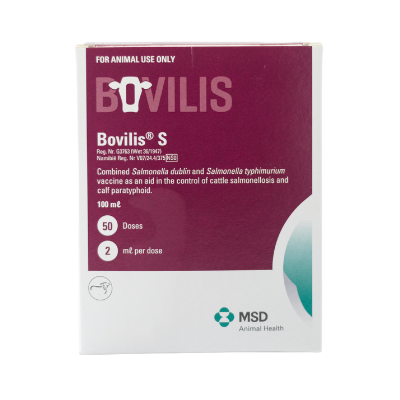Bovilis® S
An aid in the control of cattle salmonellosis and calf paratyphoid caused by Salmonella dublin and Salmonella typhimurium.

FOR ANIMAL USE ONLY
BOVILIS® S
Reg. No. G3763 (Act 36/1947)
Namibia Reg. No. V07/24.4/375 [NS0]
Suspension for Injection
INDICATIONS
Bovilis® S is indicated for the aid in control of cattle salmonellosis and calf paratyphoid caused by Salmonella Dublin and Salmonella Typhimurium.
COMPOSITION
Bovilis® S is a bivalent, inactivated, whole cell vaccine containing Salmonella Dublinand Salmonella Typhimuriumantigens. Each dose (2 mℓ) contains a minimum of 5 x 108 organisms of inactivated Salmonella Dublinand 5 x 108 organisms of inactivated Salmonella Typhimuriumwith 0,2 mg thiomersal as a preservative.
STORAGE INSTRUCTIONS
- Store between 2 °C – 8 °C in a refrigerator.
- Do not freeze. Discard if previously frozen.
- Protect from light.
WARNINGS
- Withdrawal period: Do not slaughter cattle for human consumption within 21 days after vaccination.
- Vaccinate healthy animals only.
- Avoid vaccination of animals during wet weather or under dusty conditions.
- Accidental self-injection may lead to severe local allergic reactions. Clean the affected area with a suitable disinfectant and seek medical advice.
- Partly used containers should be disposed of at the end of each day’s operation since under field conditions, it may be difficult to avoid accidental contamination of the vaccine.
- Do not over- or under-dose the vaccine.
- Do not inject intravenously.
- KEEP OUT OF REACH OF CHILDREN, UNINFORMED PERSONS AND ANIMALS.
- Although this vaccine has been extensively tested under a large variety of conditions, failure thereof may ensue as a result of a wide range of reasons. If this is suspected, seek veterinary advice and notify the registration holder.
PRECAUTIONS
- Observe aseptic precautions. Ensure that vaccination equipment (needles, syringes, etc.) is clean and sterile prior to use by boiling for at least 20 minutes.
- Do not use disinfectants or antiseptics to sterilise any equipment. Ensure that all equipment is kept clean and sterile during vaccination.
- It is good vaccination practice when handling vaccines to avoid contact with the eyes, hands, skin and clothing.
- Do not eat, drink or smoke whilst handling the product.
- Use entire contents when container is first opened and do not store partially used containers for future use.
- Adhere to the vaccination programme to obtain optimum results.
- Do not contaminate rivers, dams or any water sources with containers or waste.
- Repeated exposure may cause allergic disorders. Wash hands thoroughly after use.
- Destroy any unused vaccine and dispose of all the vaccine containers and disposable equipment after use in accordance with National Environmental Management: Waste Act, 2008 (Act No. 59 of 2008).
DIRECTIONS FOR USE – USE ONLY AS DIRECTED
- Shake well before and during use.
- Before vaccination, the site of vaccination may be cleansed by swabbing with cotton wool dipped in antiseptic.
- Use needles of appropriate length and gauge i.e. 16-gauge 15 mm.
- For subcutaneous injection only.
Dosage and Administration
Administer 2 mℓ subcutaneously. The recommended site of injection is that used for routine injection in cattle i.e. under the skin in the neck.
Vaccination Programme
- It is recommended that cows should be vaccinated twice with a 2 mℓ subcutaneous injection 3 to 4 weeks apart.
- A booster dose is given every 12 months.
- For colostrum protection, vaccinate pregnant cows approximately 8 and 3 weeks before calving.
- Calves should be fed colostrum from vaccinated dams for at least 5 days after birth.
Herd Management
In addition to vaccination with Bovilis® S, the following management techniques should be employed:
- Calves should be fed colostrum from vaccinated dams mixed at a rate of 10 % diluted with milk replacer for up to 5 days after birth.
- Maintain adequate levels of hygiene throughout the farm and minimise stressful situations.
- Good calf rearing practices are essential.
- After natural challenge with Salmonella, vaccinated animals may develop mild disease but do not shed the organisms.
PRESENTATION
Polyethylene terephthalate (PET) vials of 20 mℓ and 100 mℓ, with nitryl rubber stopper and aluminium cap. One vial per carton. Not all pack sizes may necessarily be marketed.
REGISTRATION HOLDER
Intervet South Africa (Pty) Ltd.
20 Spartan Road
Spartan, 1619, RSA
Tel: +27 (0) 11 923 9300
E-mail: msdahza@msd.com
www.msd-animal-health.co.za
DATE OF PUBLICATION OF PACKAGE INSERT 1 September 2022
